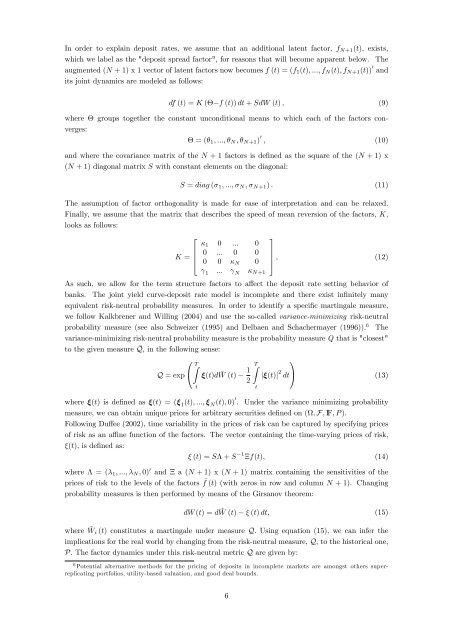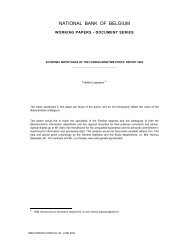A multi-factor model for the valuation and risk management of ...
A multi-factor model for the valuation and risk management of ...
A multi-factor model for the valuation and risk management of ...
Create successful ePaper yourself
Turn your PDF publications into a flip-book with our unique Google optimized e-Paper software.
In order to explain deposit rates, we assume that an additional latent <strong>factor</strong>, f N+1 (t), exists,<br />
which we label as <strong>the</strong> "deposit spread <strong>factor</strong>", <strong>for</strong> reasons that will become apparent below. The<br />
augmented (N + 1) x 1 vector <strong>of</strong> latent <strong>factor</strong>s now becomes f (t) = (f 1 (t); :::; f N (t); f N+1 (t)) 0 <strong>and</strong><br />
its joint dynamics are <strong>model</strong>ed as follows:<br />
df (t) = K ( f (t)) dt + SdW (t) ; (9)<br />
where groups toge<strong>the</strong>r <strong>the</strong> constant unconditional means to which each <strong>of</strong> <strong>the</strong> <strong>factor</strong>s converges:<br />
= ( 1 ; :::; N ; N+1 ) 0 ; (10)<br />
<strong>and</strong> where <strong>the</strong> covariance matrix <strong>of</strong> <strong>the</strong> N + 1 <strong>factor</strong>s is de…ned as <strong>the</strong> square <strong>of</strong> <strong>the</strong> (N + 1) x<br />
(N + 1) diagonal matrix S with constant elements on <strong>the</strong> diagonal:<br />
S = diag ( 1 ; :::; N ; N+1 ) : (11)<br />
The assumption <strong>of</strong> <strong>factor</strong> orthogonality is made <strong>for</strong> ease <strong>of</strong> interpretation <strong>and</strong> can be relaxed.<br />
Finally, we assume that <strong>the</strong> matrix that describes <strong>the</strong> speed <strong>of</strong> mean reversion <strong>of</strong> <strong>the</strong> <strong>factor</strong>s, K,<br />
looks as follows:<br />
K =<br />
2<br />
6<br />
4<br />
3<br />
1 0 ::: 0<br />
0 ::: 0 0<br />
7<br />
0 0 N 0 5 ; (12)<br />
1 ::: N N+1<br />
As such, we allow <strong>for</strong> <strong>the</strong> term structure <strong>factor</strong>s to a¤ect <strong>the</strong> deposit rate setting behavior <strong>of</strong><br />
banks. The joint yield curve-deposit rate <strong>model</strong> is incomplete <strong>and</strong> <strong>the</strong>re exist in…nitely many<br />
equivalent <strong>risk</strong>-neutral probability measures. In order to identify a speci…c martingale measure,<br />
we follow Kalkbrener <strong>and</strong> Willing (2004) <strong>and</strong> use <strong>the</strong> so-called variance-minimizing <strong>risk</strong>-neutral<br />
probability measure (see also Schweizer (1995) <strong>and</strong> Delbaen <strong>and</strong> Schachermayer (1996)). 6 The<br />
variance-minimizing <strong>risk</strong>-neutral probability measure is <strong>the</strong> probability measure Q that is "closest"<br />
to <strong>the</strong> given measure Q, in <strong>the</strong> following sense:<br />
0<br />
1<br />
TZ<br />
TZ<br />
Q = exp @ (t)dW 1<br />
(t) j(t)j 2 dtA (13)<br />
2<br />
t<br />
where (t) is de…ned as (t) = ( 1 (t); :::; N (t); 0) 0 . Under <strong>the</strong> variance minimizing probability<br />
measure, we can obtain unique prices <strong>for</strong> arbitrary securities de…ned on (; F; IF; P ).<br />
Following Du¤ee (2002), time variability in <strong>the</strong> prices <strong>of</strong> <strong>risk</strong> can be captured by specifying prices<br />
<strong>of</strong> <strong>risk</strong> as an a¢ ne function <strong>of</strong> <strong>the</strong> <strong>factor</strong>s. The vector containing <strong>the</strong> time-varying prices <strong>of</strong> <strong>risk</strong>,<br />
(t), is de…ned as:<br />
(t) = S + S 1 f(t); (14)<br />
where = ( 1 ; :::; N ; 0) 0 <strong>and</strong> a (N + 1) x (N + 1) matrix containing <strong>the</strong> sensitivities <strong>of</strong> <strong>the</strong><br />
prices <strong>of</strong> <strong>risk</strong> to <strong>the</strong> levels <strong>of</strong> <strong>the</strong> <strong>factor</strong>s f (t) (with zeros in row <strong>and</strong> column N + 1). Changing<br />
probability measures is <strong>the</strong>n per<strong>for</strong>med by means <strong>of</strong> <strong>the</strong> Girsanov <strong>the</strong>orem:<br />
t<br />
dW (t) = d ~ W (t) (t) dt; (15)<br />
where ~ W i (t) constitutes a martingale under measure Q: Using equation (15), we can infer <strong>the</strong><br />
implications <strong>for</strong> <strong>the</strong> real world by changing from <strong>the</strong> <strong>risk</strong>-neutral measure, Q, to <strong>the</strong> historical one,<br />
P: The <strong>factor</strong> dynamics under this <strong>risk</strong>-neutral metric Q are given by:<br />
6 Potential alternative methods <strong>for</strong> <strong>the</strong> pricing <strong>of</strong> deposits in incomplete markets are amongst o<strong>the</strong>rs superreplicating<br />
portfolios, utility-based <strong>valuation</strong>, <strong>and</strong> good deal bounds.<br />
6
















